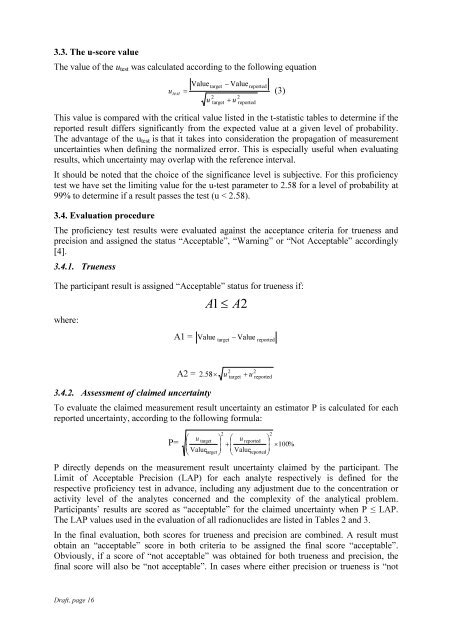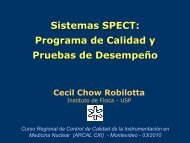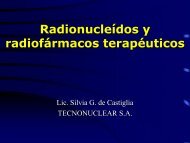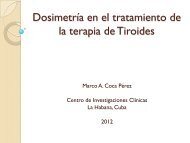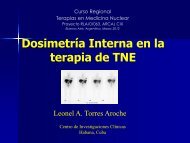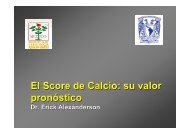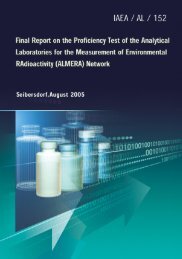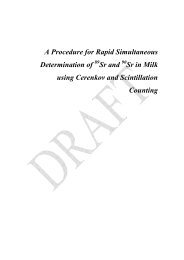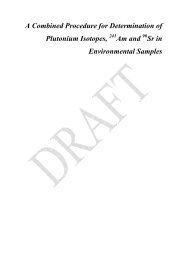Worldwide Open Proficiency Test: Determination of ... - Nucleus - IAEA
Worldwide Open Proficiency Test: Determination of ... - Nucleus - IAEA
Worldwide Open Proficiency Test: Determination of ... - Nucleus - IAEA
You also want an ePaper? Increase the reach of your titles
YUMPU automatically turns print PDFs into web optimized ePapers that Google loves.
3.3. The u-score value<br />
The value <strong>of</strong> the utest was calculated according to the following equation<br />
Draft, page 16<br />
target<br />
reported Value<br />
Value −<br />
utest = (3)<br />
u + u<br />
2<br />
target<br />
2 reported<br />
This value is compared with the critical value listed in the t-statistic tables to determine if the<br />
reported result differs significantly from the expected value at a given level <strong>of</strong> probability.<br />
The advantage <strong>of</strong> the utest is that it takes into consideration the propagation <strong>of</strong> measurement<br />
uncertainties when defining the normalized error. This is especially useful when evaluating<br />
results, which uncertainty may overlap with the reference interval.<br />
It should be noted that the choice <strong>of</strong> the significance level is subjective. For this pr<strong>of</strong>iciency<br />
test we have set the limiting value for the u-test parameter to 2.58 for a level <strong>of</strong> probability at<br />
99% to determine if a result passes the test (u < 2.58).<br />
3.4. Evaluation procedure<br />
The pr<strong>of</strong>iciency test results were evaluated against the acceptance criteria for trueness and<br />
precision and assigned the status “Acceptable”, “Warning” or “Not Acceptable” accordingly<br />
[4].<br />
3.4.1. Trueness<br />
The participant result is assigned “Acceptable” status for trueness if:<br />
where:<br />
A≤ 1 A2<br />
A1 = target<br />
reported Value<br />
Value −<br />
A2 =<br />
3.4.2. Assessment <strong>of</strong> claimed uncertainty<br />
2<br />
target<br />
2. 58×<br />
u + u<br />
2 reported<br />
To evaluate the claimed measurement result uncertainty an estimator P is calculated for each<br />
reported uncertainty, according to the following formula:<br />
⎛ u ⎞ ⎛ u<br />
+<br />
⎜ Value ⎟ ⎜<br />
⎝ target ⎠ ⎝<br />
Value<br />
2<br />
P= ⎜ target ⎟ ⎜ reported ⎟ × 100%<br />
P directly depends on the measurement result uncertainty claimed by the participant. The<br />
Limit <strong>of</strong> Acceptable Precision (LAP) for each analyte respectively is defined for the<br />
respective pr<strong>of</strong>iciency test in advance, including any adjustment due to the concentration or<br />
activity level <strong>of</strong> the analytes concerned and the complexity <strong>of</strong> the analytical problem.<br />
Participants’ results are scored as “acceptable” for the claimed uncertainty when P ≤ LAP.<br />
The LAP values used in the evaluation <strong>of</strong> all radionuclides are listed in Tables 2 and 3.<br />
In the final evaluation, both scores for trueness and precision are combined. A result must<br />
obtain an “acceptable” score in both criteria to be assigned the final score “acceptable”.<br />
Obviously, if a score <strong>of</strong> “not acceptable” was obtained for both trueness and precision, the<br />
final score will also be “not acceptable”. In cases where either precision or trueness is “not<br />
reported<br />
⎞<br />
2<br />
⎟<br />
⎠


